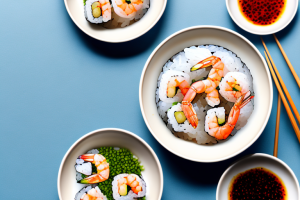How to prepare sushi rice with avocado and cucumber rolls
8 min read
An avocado
Sushi is a popular Japanese dish that has gained popularity all over the world owing to its unique blend of flavors and textures. One of the most popular sushi rolls is the classic avocado and cucumber roll, which is not only delicious but also easy to prepare at home. In this article, we’ll go through all the steps to prepare perfect sushi rice and create delicious avocado and cucumber rolls, as well as some useful tips, tricks, and other useful information you need to know about making sushi at home.
The health benefits of eating sushi
Sushi is not only tasty but also packed with many health benefits. Due to its low-fat content and high protein, it’s considered an excellent source of nutrition. The seaweed used in sushi also contains many essential nutrients, such as calcium, iron, and iodine, in addition to being rich in antioxidants.
Another health benefit of eating sushi is that it can help improve heart health. The omega-3 fatty acids found in fish, such as salmon and tuna, can help reduce the risk of heart disease by lowering triglyceride levels and reducing inflammation in the body.
In addition, sushi can also aid in weight loss. Sushi rolls are typically low in calories and high in protein, which can help you feel full and satisfied for longer periods. Choosing sushi rolls with vegetables, such as cucumber or avocado, can also provide additional fiber and nutrients to your diet.
The history of sushi and its evolution into a popular dish worldwide
Sushi has a long history that stretches back more than 2,000 years in Japan. It has evolved over time to include different ingredients and techniques, eventually becoming a popular dish worldwide. Today, sushi is enjoyed by people of all ages and cultures around the world.
One of the reasons for sushi’s popularity is its health benefits. Sushi is often made with fresh fish, which is a great source of protein and omega-3 fatty acids. Additionally, the use of vinegar in the rice helps to preserve the fish and prevent the growth of harmful bacteria. Sushi is also low in calories and fat, making it a great option for those looking to maintain a healthy diet.
A step-by-step guide to making the perfect sushi rice at home
The secret to making great sushi lies in the quality of the rice. Follow these steps to make perfect sushi rice at home:
- Wash the sushi rice until the water runs clear.
- Combine the rice with water in a pot and cook on medium heat for 15-20 minutes until all the water has been absorbed.
- In a separate pan, mix rice vinegar, sugar, and salt, and heat until the sugar dissolves.
- Pour the vinegar mixture over the cooked rice and mix gently.
However, there are a few additional tips to keep in mind when making sushi rice. Firstly, it’s important to use the correct ratio of rice to water. For every cup of rice, use one and a quarter cups of water. Additionally, once the rice is cooked, it’s important to let it sit for at least 10 minutes before adding the vinegar mixture. This allows the rice to cool slightly and absorb the flavors of the vinegar mixture more effectively.
Another important factor to consider is the type of rice you use. Short-grain Japanese rice is the best option for making sushi, as it has a sticky texture that holds together well. If you can’t find Japanese rice, look for other short-grain varieties such as Arborio or Calrose rice.
Tips for selecting the best quality ingredients for your sushi rolls
The key to making great sushi is to use fresh, high-quality ingredients. When selecting ingredients for your avocado and cucumber rolls, choose the freshest and most attractive-looking vegetables, and use high-quality, sushi-grade fish.
Another important factor to consider when selecting ingredients for your sushi rolls is the seasonality of the ingredients. For example, if you are making a salmon roll, it is best to use salmon that is in season, as it will be at its freshest and most flavorful. Additionally, using seasonal ingredients can add variety and interest to your sushi rolls, as you can experiment with different flavors and textures throughout the year.
It is also important to consider the source of your ingredients. Look for suppliers who prioritize sustainability and ethical practices, and who can provide information about the origin and quality of their products. By choosing ingredients from responsible sources, you can ensure that your sushi rolls are not only delicious, but also environmentally and socially responsible.
Creative variations on traditional avocado and cucumber rolls
While traditional avocado and cucumber rolls are delicious, you can create new flavor combinations by adding different ingredients such as sesame seeds, crab, or mango. Adding slightly-spicy wasabi sauce can also give your sushi a tangy kick.
Another way to add a twist to your avocado and cucumber rolls is by using different types of rice. You can try using black rice, which has a nutty flavor and a striking color, or brown rice for a healthier option. Additionally, you can experiment with different types of seaweed wrappers, such as soy paper or even fruit wraps made from thinly sliced apples or pears.
The art of rolling sushi: techniques, and tools you’ll need to know
With a little practice, rolling sushi is a skill that anyone can learn. To get started, you’ll need a bamboo rolling mat, which is readily available in most grocery stores. To roll the sushi, place the ingredients on the nori or seaweed sheet, then fold the mat over and roll tightly to create the shape of the sushi roll.
One important technique to keep in mind when rolling sushi is to not overfill the roll. This can cause the roll to break apart or become too bulky to eat. It’s also important to wet your hands before handling the rice, as this will prevent it from sticking to your fingers. Additionally, using high-quality ingredients, such as fresh fish and vegetables, will greatly enhance the flavor of your sushi rolls.
Pairing sake, and other beverages with your homemade sushi creations
Sake is the perfect beverage to pair with sushi as it has a smooth, sweet flavor that complements the dish’s delicate flavors. However, you can also pair your sushi with other beverages such as green tea, beer, or white wine, which can also be a good option.
When it comes to pairing sushi with green tea, it is important to choose a high-quality tea that has a subtle, yet complex flavor. The earthy and slightly bitter taste of green tea can help to balance out the richness of the sushi, making for a well-rounded dining experience. If you prefer beer, a light and crisp lager or pilsner can be a great choice to cut through the fattiness of the fish. Finally, if you’re a fan of white wine, a dry and acidic option like a Sauvignon Blanc or Pinot Grigio can complement the flavors of the sushi without overpowering them.
How to store leftover sushi rice and rolls for maximum freshness
Once you’ve finished rolling sushi, you can store the leftovers in the refrigerator for up to two days. Wrap the leftover sushi rolls tightly in plastic wrap to keep them fresh. To reheat the sushi, place it in a microwave for a few seconds or in a warm skillet to give it a fresh, crispy texture.
It’s important to note that while leftover sushi can be stored in the refrigerator, it’s best to consume it as soon as possible to ensure maximum freshness and flavor. If you’re not able to finish all of your sushi in one sitting, consider making smaller portions or sharing with friends to avoid waste. Additionally, avoid storing sushi in the freezer as it can negatively affect the texture and taste of the rice and fish.
Common mistakes to avoid when making homemade sushi for the first time
Making sushi can be an intimidating process, especially if you’re doing it for the first time. One of the most common mistakes people make when making sushi is using too much filling, which can lead to loose or uneven rolls. Other common mistakes include using the wrong type of rice, over or under-seasoning the rice vinegar mixture, and not cutting the rolls correctly.
Another common mistake to avoid when making homemade sushi for the first time is not properly preparing the ingredients. It’s important to make sure that the fish is fresh and properly sliced, and that any vegetables or other fillings are cut into thin, uniform pieces. Additionally, it’s important to have all of your ingredients and tools ready before you start rolling, as sushi-making can be a time-sensitive process. By properly preparing your ingredients and having everything ready to go, you can help ensure that your homemade sushi turns out delicious and visually appealing.
Frequently asked questions about making sushi at home
Some frequently asked questions about making sushi at home include how long it takes to make sushi, how much sushi rice to use per roll, how to make vegetarian sushi, and the nutrition content of sushi.
Another common question is what type of fish is best to use for sushi. It is recommended to use sushi-grade fish, which is fish that has been frozen at a certain temperature to kill any potential parasites. Some popular types of fish used for sushi include salmon, tuna, and yellowtail.
Sushi etiquette: how to eat and serve sushi like a pro
When it comes to sushi, there are a few eating and serving rules to follow. When eating sushi, use chopsticks to pick up each piece, and dip the fish side in soy sauce. When serving sushi, display it attractively on a platter and use garnishes such as shaved carrots or wasabi to add visual appeal.
Another important rule to follow when eating sushi is to not mix wasabi into the soy sauce. Instead, place a small amount of wasabi directly on top of the sushi before dipping it into the soy sauce. This ensures that the flavors of the wasabi and soy sauce do not overpower the delicate taste of the sushi.
It is also important to eat sushi in the correct order. Start with the lighter, milder fish and work your way up to the richer, fattier fish. This allows your taste buds to fully appreciate the flavors of each type of sushi.
Vegan and vegetarian options for making delicious avocado and cucumber rolls
If you’re a vegan or vegetarian, you can still enjoy delicious avocado and cucumber rolls by substituting fish with tofu or seitan. Vegetable-based sushi fillings such as cucumber, avocado, and sweet potato, make delicious and healthy alternatives.
The best sauces, and toppings to complement your homemade sushi creations
Sauces and toppings can add extra flavor and texture to your avocado and cucumber roll. Common sushi toppings include thinly-sliced ginger, wasabi paste, or toasted sesame seeds. Popular sushi sauces include soy sauce, spicy mayonnaise, and eel sauce.
Hosting a successful sushi party: tips, tricks, and menu ideas
Sushi parties are a fun and exciting way to entertain your guests. For successful sushi parties, make sure you have all the ingredients and tools you need, like a sushi mat and sushi rice. You can also create different variations of sushi by using different ingredients or shapes, such as sushi bowls or sushi bites. Other Japanese-inspired dishes like edamame and miso soup also make great sides.
In conclusion, sushi making is a fun activity that anyone can enjoy at home. With a little practice, you can create delicious sushi rolls that are not only healthy but also cost-effective and enjoyable for everyone involved.


